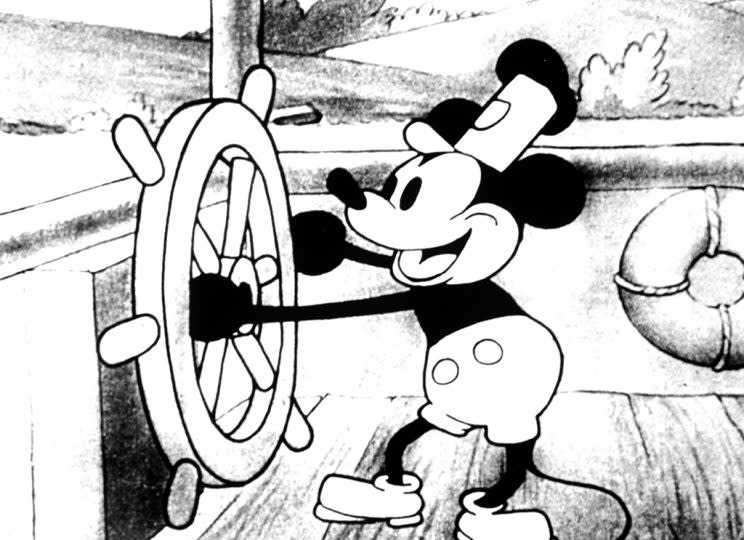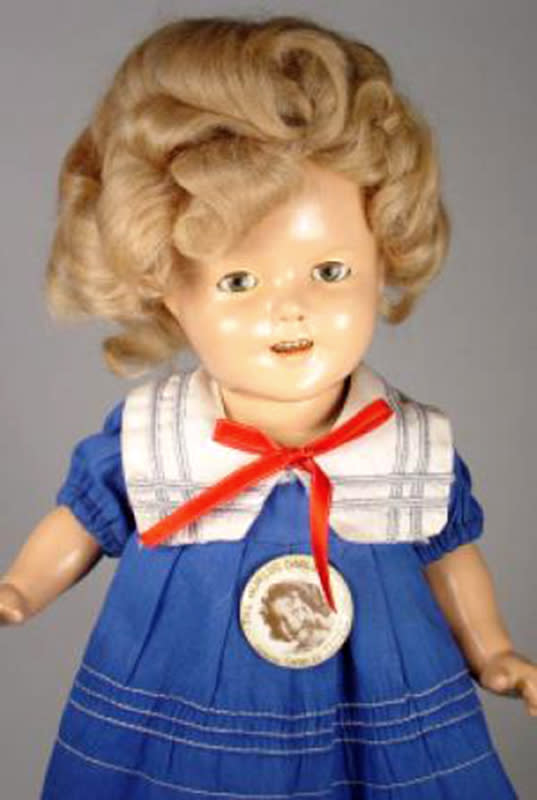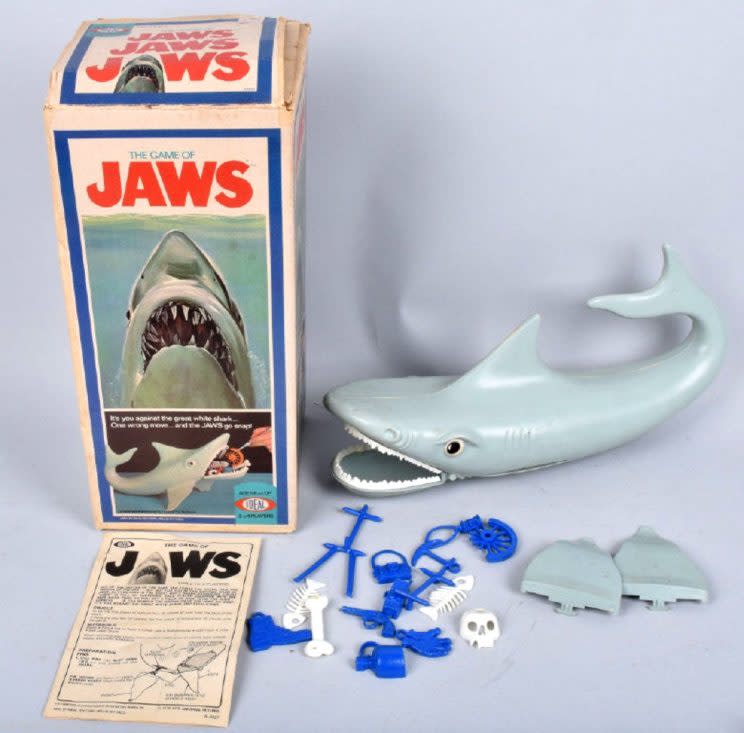Merch Mania! From 'Steamboat Willy' to 'Batman,' a Timeline of Movie Tie-In Toys

With the release of the latest round of Star Wars merchandise set for this year’s so-called Rogue Friday (riffing on last year’s Force Friday) on Sept. 30, Yahoo Movies looks back at movie merchandise through the years. In today’s fifth installment, an exhaustive timeline of merch through the ages.
Before Star Wars, there was nothing. Or at least, very little. In the decades leading up to the release of George Lucas’s 1977 masterpiece, movie merchandising was not very common and not very lucrative. The business was ruled by icons such as Mickey Mouse and stars of the small screen. But Star Wars changed everything. No longer were people just watching their favorite characters on screen — they were dressing up like Stormtroopers, playing with toy Yodas, and eating candy out of a tiny Darth Vader helmets. On Sept. 30, the franchise will do what it does best and entice people to buy stuff with loads of Rogue One-related products. But before you bust out the credit card, let’s see how we got here, with our timeline of movie merchandising, which starts before movies were very important at all.
Related: New ‘Rogue One’ Topps Trading Cards Drawn to the Dark Side
1921 — The Wonderful Game of Oz hits stores. A promotional tie-in for the 15th book in L. Frank Baum’s Oz series, the game board featured a brightly colored map of the entire land of Oz, making it a must-have for readers of Baum’s books. The game would remain on shelves until the film adaptation of Baum’s book was released 18 years later.
1929 — A year after the release of Steamboat Willie, Walt Disney cuts a $300 deal with a stationary company to allow his prized character’s image to appear on writing tablets, in what is commonly thought of as the first instance of movie merchandising.
1932 — Signal Oil and Gas, a sponsor of the Tarzan radio show, releases a Tarzan jigsaw puzzle one piece at a time over six weeks, enticing customers to pick up a new piece each time they fill up. At the time, the Tarzan brand is ubiquitous: Author Edgar Rice Burroughs is still publishing Tarzan stories, there’s a popular newspaper comic strip, and in March of 1932, Johnny Weissmuller appears in Tarzan the Ape Man, the first of 12 Tarzan films for the man with the golden vocal chords.
1932 — Disney hires merchandising man Herman “Kay” Kamen to lead its efforts to license Mickey Mouse. Kamen quickly proves to be a commercial genius. He publishes a manual for theater owners, providing tips on coordinating film openings with local shops selling Mickey merch and licenses the iconic rodent’s image to dozens of companies that pay from 2.5 to 10 percent in royalties. One key to his success is writing into contracts a requirement for Disney to approve products for quality before they go to market. Kamen is so successful so quickly, that by 1937 one analyst proclaimed Mickey Mouse “the greatest thing in the history of merchandising.”
1934 — Walt Disney admits that he’s making more money from Mickey Mouse merchandising than from the character’s cartoons, as annual profits for Mickey products exceed $600,000.

1935 — The first Shirley Temple dolls are produced to coincide with the release of The Littlest Rebel. While Temple-branded dresses are also a hit, the dolls sell like mad. Five years after their release, as many as 1 million dolls had been sold. Today, they’re a valuable collector’s item.
1937 — Snow White is released and is the “first film to have a complete merchandising campaign in place by the day the film opened.” Disney has around 70 deals for snacks, books, toys, and clothes, among other things, prepared for the film’s release.
1950 — William Boyd, the actor who began playing Hopalong Cassidy in 1935 and appeared in more than 60 movies as the heroic cowboy, rakes in the equivalent of $7.7 million in today’s money on 73 licenses that result in 2,400 different products. The fortune was the result of a smart deal the actor struck when he bought the rights to the character two years prior, after the film franchise was killed. Boyd offered the old films up to NBC, and the fledgling network bit. NBC and Boyd helped create the TV western with old Hopalong movies and sold truckloads of licensed products along the way.
Related: A Field Guide to Major Movie Merchandising Misfires, From ‘Alien’ to ‘Waterworld’
1964 — With the small screen dominating merchandising in the U.S., James Bond fans in the U.K. can’t get enough of 007 following the release of Goldfinger. The movie, along with Ian Fleming’s death in 1964, sets off an infatuation with all things Bond. By February of 1966, fans have spent $50 million on Bond board games, puzzles, clothes and toys.
1967 — Hollywood attempts to wrest merchandising supremacy from TV, and Fox thinks Dr. Dolittle is the film to do it. Hundreds of products are produced, including cereals, detergent, and dog food, but no one would buy them. It is estimated that $200 million in merchandise went unsold, giving studios a scare bad enough that they shied away from merchandising for years.

1975 — Universal rolls out an aggressive marketing campaign for Jaws, which includes an astonishing array of tie-in items, including beach towels, toy sharks, iron-ons, shark-tooth necklaces, water pistols, and pajamas. Among the best-selling items was a promotional plastic cup, which sold 1.5 million units only two months after the film was released. By the same point, the movie’s famed soundtrack had moved 200,000 units.

1977 — Despite Universal’s success with Jaws, Fox was still not eager to get back into the merchandising game. So when director George Lucas agreed to take a $500,000 pay cut to retain merchandising and sequel rights, the studio agreed. It was a massive mistake. Lucas always knew the film was “toyetic” and has admitted to writing it with some merch in mind. Lucas would sell the Star Wars toy-merchandising rights to Kenner, a General Mills-owned toy company. But no one — not Lucas, not Kenner, and certainly not Fox — was prepared for Star Wars to be such a hit. With terribly low supply for raging demand, Kenner sold empty boxes to placate customers while they went into production overdrive. The Star Wars Early Bird Certificate Package had images of the film’s characters, but the actual figures wouldn’t arrive in the mail for another few months.
1978 — By the end of the year, 19 months after the release of the original Star Wars, Kenner has expanded its line of tie-in toys to 20 items and its sales are galactic — more than $100 million made selling 40 million figures.

1982 — E.T. arrives in theaters and is an immediate hit. So, too, are the stuffed dolls of the adorable little alien sold by Kamar International. The toy company, which produced 400 different items at the time, shuts down production on every other item to focus on making enough E.T. dolls for Christmas time. By the end of the year, as many as 7 million E.T. dolls are sold. But people aren’t only clamoring for the stuffed alien: They want posters too, and C/C Sales, a poster manufacturer in Chicago obliges. Sales outpace even the iconic Farrah Fawcett poster released six years prior. “Honest to Pete, I’m dreaming about it,” a sales manager for the company told New York Magazine in August of ’82.
1983 — Not all E.T. tie-ins are a success. Despite good sales upon its release, Atari’s E.T. video game comes to be known as one of the biggest commercial failures in video gaming history. In September of 1983, thousands of unsold copies are buried in a New Mexico landfill.
1986 — Kenner ends its run making Star Wars toys with worldwide sales of a quarter-billion dollars.
1989 — “Batmania” sweeps the nation as fans prepare for Tim Burton’s Batman. The promotional machine for the movie is in overdrive months before it hits theaters. As filmmaker Kevin Smith once described it, “You couldn’t turn around without seeing the Bat-Signal somewhere.” All told, the movie is believed to have done at least a half billion in merchandise sales, from toys and posters to Taco Bell cups and $500 rhinestone jackets. One genius who saw this coming: Jack Nicholson. He cut his fee in exchange for a piece of the merchandising profits, a deal that reportedly helped him make more than $50 million.
Watch a ‘Batman’ Taco Bell ad:
1999 — Lego cuts a licensing deal with Star Wars, the first in the history of the company, and begins making toys to coincide with the release of The Phantom Menace. By the end of the 2000, the Danish company has reportedly made $2 billion in sales of Star Wars toys.

2006 — Pixar releases Cars, its seventh film and a future merchandising cash cow. Despite a somewhat disappointing box-office take (for a Pixar movie, at least), Cars would make $10 billion in global retail sales over the next five years. The movie was such a merchandising monster that in 2011, Cars 2 came out for one reason — “massive licensing success.”
2011 — With the release of Harry Potter and the Deathly Hallows, Part 2, the third-highest grossing film franchise of all-time comes to an end. What does not end, though, are merchandising revenues. With $7 billion in global sales already, Harry Potter clothing, candies and other tchotchkes are expected to keep bringing in 10-figure sums each year.
2015 — Nearly 40 years after the release of Star Wars, it’s still the biggest name in the toy biz. With more than $700 million in sales in the lead-up to The Force Awakens, Star Wars is the best-selling property in the toy industry in 2015.

